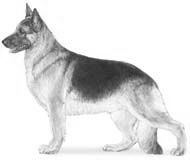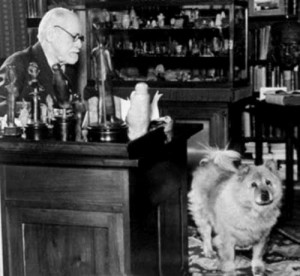
In Part I of this series, I explored Freud’s late life case of puppy love, inspired by his daughter Anna’s first dog. Here I discuss the impact his bond with dogs had on his treatment sessions — and on Anna’s.
Oddly, Freud’s pre-eminent biographer, Peter Gay, minimized the role dogs played in his subject’s life and his practice. In the sole page devoted to the topic in Freud: A Life for Our Time, Gay writes of Freud’s bonding with his first dog, Lün-Yu: “From then on, Freud and a succession of chows, especially his Jo-Fi, were inseparable. The dog would sit quietly at the foot of the couch during the analytic session.”
Not quite.
The introduction to Topsy: A Golden Haired Chow, covered more extensively in my next post, notes that “Freud’s devotion to dogs is the stuff of psychoanalytic legend.” This introduction is the source of my information about the interaction of Freud and his family dogs with Ernest Jones and the poet H.D., discussed below.
***
The Freud Family Dogs
 First, a disclaimer: I have no primary sources for this story; it comes from Allan Showalter who heard it from his teacher, Roy Grinker Sr. Grinker was analyzed by Freud from 1933 to 1935 and founded the psychiatry program at Michael Reese Hospital in Chicago.
First, a disclaimer: I have no primary sources for this story; it comes from Allan Showalter who heard it from his teacher, Roy Grinker Sr. Grinker was analyzed by Freud from 1933 to 1935 and founded the psychiatry program at Michael Reese Hospital in Chicago.
According to Showalter in Freud and His Damn Dog:
Freud and his daughter, Anna (also an analyst), both kept dogs (Freud had a chow named Yofi and Anna had a giant wolfhound) that had the run of the offices and shared waiting room. Both dogs would start barking whenever anyone rang the doorbell. The wolfhound… would immediately start sniffing Grinker’s genitals. Grinker reported that, as a consequence, he always entered Freud’s office ‘with a high level of castration anxiety.’
Further:
At Freud’s seminar, the wolfhound once lay next to [Grinker] and barked, causing Anna Freud to tell him that the dog was ‘perfectly safe.’ After a pause, she went on to point out that, of course, when the dog was younger, he had a habit of eviscerating sheep. Then she repeated that now he was perfectly safe. Finally, she advised Grinker to pull his tail to make him stop barking. Grinker opted not to follow that suggestion.
I was a little dubious about that story — including the fact that Anna Freud’s dog is described as a “wolfhound” when he is a German shepherd named Wolf — but apparently “wolfehund,” like “Alsatian,” is an alternative name for the breed in German. And psychoanalyst Ernest Jones, Freud’s early, official biographer, describes a similar encounter with Wolf by saying, “He flew at me and tore a piece of my thigh.” In response, Freud only noted that dogs instinctively know who dislike them or fear them.
Freud’s Canine Timekeeper
The notion that Freud kept Yofi with him in the office while he was seeing patients has several sources.
According to the London Guardian:
Analysis became wearisome for Freud as [his jaw] cancer took its toll but Jofi sat with him, a patient listener but one with an eye on the clock, signalling the end of every session with copious yawning and stretching, never allowing Freud to exceed the statutory hour by even a minute.
Stanley Coren, a psychologist who writes often about dog behavior and intelligence, says in an excerpt from What Do Dogs Know:
Freud felt that dogs had a special sense that allows them to judge a person’s character accurately. For this reason his favorite chow-chow, Jofi, attended all of his therapy sessions; Freud admitted that he often depended upon Jofi for an assessment of the patient’s mental state. He also felt that the presence of the dog seemed to have a calming influence on all patients….
Jofi would alert him to any stress or tension in a patient by where he lay down during the session. He lay relatively close to calm patients, but would stay across the room if the patient was tense. Jofi also helped the great psychoanalyst determine when a therapy session was finished by unfailingly getting up and moving toward the office door when the hour was up
Overzealous guard dog?
Like German Shepherds, chows are not known as a calm breed. Freud warned one of his patients, the poet H.D., to approach Jofi with caution. H.D. ignored him and cozied up to Yofi but, like Anna, found a rival in Freud’s dog: “I was annoyed at the end of my session as Yofi would wander about and I felt that the Professor was more interested in Yofi than he was in my story.”
And from Grinker via Showalter again:
Yofi…would sit alongside Grinker’s couch and, as dogs are wont to do, eventually scratch at the door to be let out. Freud would let the dog out, and, on his return to his chair, note that Yofi hadn’t thought much of what Grinker had been talking about. When the dog would later scratch to get back in the office, Freud would comment that Yofi had decided to give Grinker another chance.
In another episode, Grinker was emoting with intensity when, as Grinker explained it, “The damn dog jumped on top of me.” Freud immediately responded — by commenting that Yofi was excited that Grinker had discovered the roots of his anxiety.
I hope this story is true for the light it sheds on Freud’s personality. The title of this post is an ironic reference to David Cronenberg’s “A Dangerous Method.” The Freud who I am increasingly coming to know through these and other anecdotes was not the humorless priss of Cronenberg’s film but, instead, more like the Viennese Jew with a dry wit that I grew up with — my father.
Call me Electra.
Coming next: Dogs in Freud’s final years.

While some of these seem legends gone astray, I happen to believe the time telling one. I had a dog who had an uncanny sense of time. We know that dogs like routine, and like to do things at the same time, so that is not too surprising.
Do you think that Freud was the first to say that dogs know who likes them and who doesn’t? Or was he passing on folk wisdome. (How unscientific of him!)
I concur with that. Frankie knows exactly when it’s time for dinner, and starts reminding me about 15 minutes earlier.
As for being the first to say dogs know who likes them and who doesn’t, I’m sure he wasn’t. But I’ll be he was the first to say it to his official biographer as an explanation for why his dog bit him! Of course I don’t have any documentation for that…
I’m laughing out loud! I LOVE these stories. I’m especially taken by, and sympathetic to, Freud’s evident attachment to Yofi and his preeminence in therapy sessions. I don’t know if Freud is correct in all that he ascribes to dogs knowing what he says they know, but I’ve certainly had similar experiences with my dogs.
So glad you’re enjoying the stories, Deborah; I’m having a blast researching and writing them. I find it fascinating that the popular view of Freud — including the one presented by his most influential biographer — doesn’t include his love for dogs. Or maybe it’s because the biographer was so influential in creating a view of Freud that I was unaware of any canine connection.
Good for Freud he could enjoy his new found interest in dogs on such a late age. Those were the days in a way, where nobody worried all to much about dog behavior or training. And look how well-socialized they could have become (?), following everywhere with their master.
You are right, btw, about the german shepherd being talked about as a Wolf in german. That same connection is also made in Dutch, “wolfhond”, they say.
Anyway Grinker shouldn’t complain, a real Wolfhound would have looked DOWN at his genitales.
Leo, it’s so nice to have you on my new blog, making me laugh again. Your comment about the real Wolfhound and Grinker’s genitals made my day!
Found you on the Saturday Blog Hop. Very good blog Edie! Thank you.
Linda, thanks for stopping by! It was nice to have a good reason to hang out with my pet blogger pals again.
What a great story and welcome to Geneabloggers.
Regards, Jim
Genealogy Blog at Hidden Genealogy Nuggest
Thank you, Jim. I’m looking forwarding to reading a lot of fascinating family stories — including yours!
Welcome to the GeneaBloggers family. Hope you find the association fruitful; I sure do. I have found it most stimulating, especially some of the Daily Themes.
May you keep sharing your ancestor stories!
Dr. Bill 😉
http://drbilltellsancestorstories.blogspot.com/
Author of “13 Ways to Tell Your Ancestor Stories” and family saga novels:
“Back to the Homeplace” and “The Homeplace Revisited”
http://thehomeplaceseries.blogspot.com/
http://www.examiner.com/x-53135-Springfield-Genealogy-Examiner
http://www.examiner.com/x-58285-Ozarks-Cultural-Heritage-Examiner
http://www.examiner.com/heritage-tourism-in-springfield-mo/dr-bill-william-l-smith
http://www.squidoo.com/lensmasters/drbilltellsexcitingstories
The Heritage Tourist at In-Depth Genealogist: http://www.indepthgenealogist.com/
Thank you! I’m very impressed by the range of the genealogy community and am looking forward to bring part of it.
Thank you for sharing this story!
Your meticulous research and attention to detail bring depth to the narrative, and your storytelling captivates readers’ imaginations. It’s evident that you’ve delved into the subject with keen interest, unearthing anecdotes that provide unique insights into Freud’s character and his unconventional use of dogs during therapy sessions. Your writing showcases a deep appreciation for Freud’s personality, making him come alive in a relatable and humanizing way.